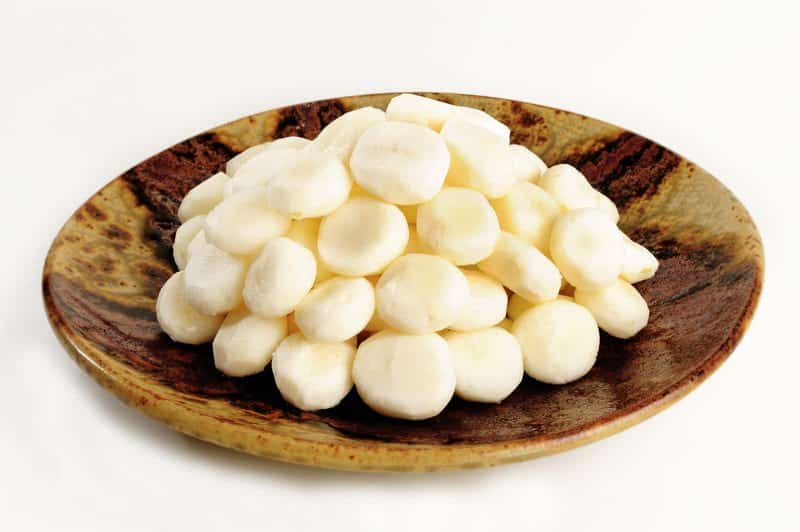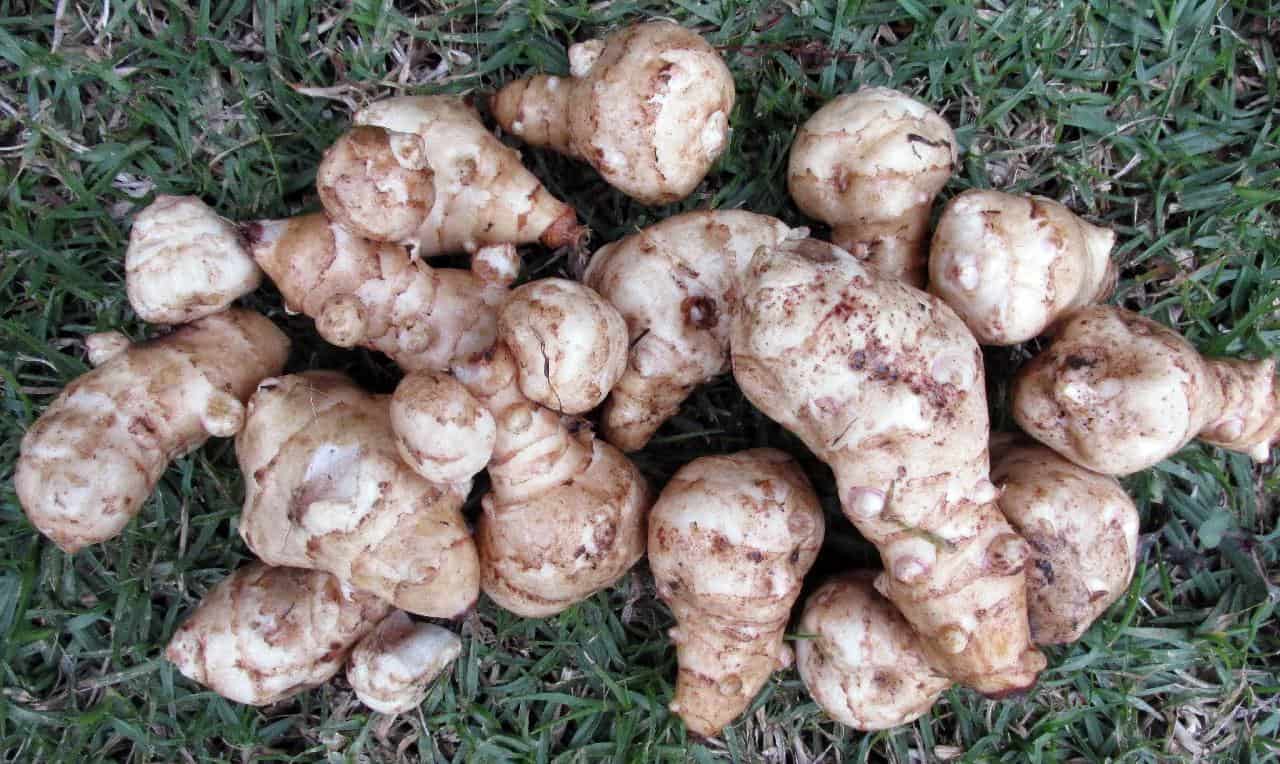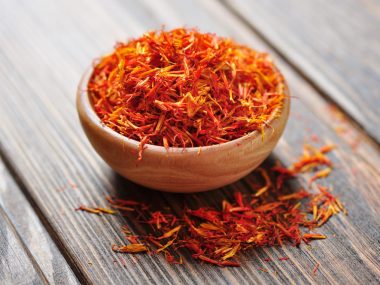Water chestnuts are a very reliable ingredient, having a crunch and a light sweetness. They are a common ingredient, especially in Chinese cuisine.
Water chestnuts have been cultivated in China since ancient times, and can now usually be found in Asian supermarkets and cuisine. The name comes from the fact that they resemble chestnuts in their shape and color.
The water chestnut is not a nut at all, but has an aquatic tuber and grows in freshwater marshes. They can be eaten raw, but this isn’t advisable because they might come with diseases from the water where they grew. But what if you can’t find any? Is there anything else that you could use instead?
Yes, you can. Even though this ingredient is commonly used in Asian cuisine, there are other common ingredients that can be used instead, like turnips, canned water chestnuts, Jerusalem artichokes and jicama slices.
Also, as there is a flour made from water chestnuts, we have listed below some substitutes for water chestnut flour. Read the article to find out more about water chestnuts in cooking, some recipe ideas and some suggested alternatives.
Substitutes for Water Chestnuts
No need to worry, water chestnuts can be substituted. Read below about our suggested alternatives that reflect almost the same taste as water chestnuts. They have the same use and are substituted with equal amounts or adapted according to taste.
1. Turnip
This is one of the cheaper substitutes for water chestnuts. Closely associated with potatoes and beets, this root vegetable originated in eastern Asia and was cultivated around the Roman Empire.
To use as a substitute for water chestnuts, cut the turnip into slices and add it to some oil along with a little salt and water. Cover it and cook until soft. You can add this alternative to many Eastern cuisines and also eat them as a side dish.
They have a slightly spicy flavor and the older ones develop a pronounced mustard flavor which mellows during the cooking process.
2. Canned water chestnuts
If you can’t find fresh ones, you can always use canned water chestnuts. They taste almost the same as fresh ones, although the fresh ones have a nuttier taste. You can always substitute one for the other because they are practically the same.
3. Jerusalem Artichokes
Another useful option is the Jerusalem artichoke. Derived from the sunflower, it is a lumpy, brown-skinned tuber that resembles a ginger root. It is white, nutty, sweet and crunchy and contains a good amount of iron. It is an excellent substitute in many recipes. Substitute equal amounts of Jerusalem artichokes for water chestnuts.
4. Jicama Slices
This is a root vegetable with papery, golden-brown skin and a very starchy white interior. It was originally grown in Mexico and has now spread all over Asia. It needs a long growing season and usually thrives in warmer countries. It is very juicy, with a slightly sweet and nutty flavor which is similar to the chestnut. Use equal amounts or adapt quantities according to taste.
Water Chestnut Flour Substitutes
Water chestnut flour is made from dried, ground water chestnuts. The water chestnuts are firstly boiled, then peeled and dried before being made into flour.
The flour is commonly used as a thickener. Also, in Asian cuisine water chestnut flour is used to improve deep-fried recipes. It gives the food a light crust and stays white even when fried.
However, if you don’t have any water chestnut flour to hand, don’t worry – just look at the list of substitutes below.
5. Almond Flour
This substitute for water chestnut flour has a very rich protein content and also, importantly, it’s gluten-free. You can make it at home by grinding blanched sweet almonds or you can simply buy it in a health-food store. It is more granular and less sweet than water chestnut flour.
6. Hazelnut Flour
This flour is made from raw hazelnuts and is a very suitable substitute for water chestnut flour. Hazelnut flour is a grain-free nut flour, which makes it really good for baking.
This flour is also gluten-free and it can be used to bread chicken, fish or can be added to smoothies. It contains more fat than water chestnut flour, which can make your finished product a little more dense.
Water Chestnut as an ingredient:
Commonly used in Chinese recipes, water chestnuts are often used in vegetable stir-fries and are also part of a classic bacon appetizer. They are also used to add crunch to a creamy spinach dip and bring an exotic flavor to vegetable side dishes. They are usually added at the end of the cooking process.
Water chestnuts are highly nutritious and contain high amounts of fiber, potassium, magnesium and copper. They also contain vitamin B6 and riboflavin and their calories come from carbs.
The freshly picked freshwater chestnuts have a different taste to the canned ones. They have a fruity and nutty flavor which is also sweet – a little like a cross between an apple and coconut. Whereas the canned ones have barely any flavor at all.
How to prepare water chestnuts: recipe ideas
Canned water chestnuts are prepared in a different way from the fresh ones. The top and the bottom need to be cut off. They also need peeling and rinsing in cold water.
They can be peeled ahead of time and stored in cold water in your fridge. Rinse them under warm running water before using them.
Here are some recipe ideas that you can add water chestnuts as a side dish:
- Water chestnut cake
- Chicken lettuce wraps
- Broccoli Beef Lo Mein
- Balsamic Pork Stir-Fry
- Baked spring rolls
Related Questions:
Is a chestnut the same as a water chestnut?
Tree chestnuts are shiny brown nuts that grow from catkin flowers. Whereas the water chestnuts are underground stems called corms or tubers and they have to be dug up in order to harvest them. So no, they are not the same, and they taste different.
How to cook water chestnuts?
All you have to do is put them in a small bowl and pour over 2 tablespoons of olive oil. Sprinkle 1 tablespoon of salt and ½ tablespoon of black pepper over the chestnuts. Stir the mixture until the water chestnuts are seasoned. Spread them over a pan and roast them for 15 minutes.
Do I need to cook water chestnuts?
Freshwater chestnuts can be eaten raw but you have to peel them before eating. Whether you are using fresh or canned water chestnuts in cooking, add them at the end of the cooking time so that they retain the maximum crunch and fit well in the recipe.





2 comments
Hi
I’m so happy to have come across your Blog ‘SubstituteCooking.com’
I was looking for a substitute for Water Chestnuts 🌰 I have fresh Chicken Livers.. I’d like to make Ramachi but, do not have Water Chestnuts in my pantry @ the moment. My hubby (recently Retired!😬) says, just “Go to the store & buy a can.. you’ll probably see other things to buy, too.”
Well, it’s my day off & I’m not ready to run errands yet! It’s cold in Wisconsin today.. I enjoy the cold but, I just want to be ‘home’ enjoying my day off & the beautiful Fire my hubby has burning in the Fireplace! 🍁I love Fall!🍂
🥰 I will Bookmark your Blog bc I use a lot of “Substitutes”! My Mom was a great Cook & she taught us to substitute when necessary to continue on w/your Recipe!
There’s ‘almost always’ a substitute available.. Right! 😉I’ll be visiting your site often!
I’m Looking forward to checking it out.. so far it’s only been the Water Chestnut issue..
Thanks for creating your Blog on “Substitutes” ..it’s right up my alley! 🙏•🤗•😁
Keep up the good work!👌
A Very appreciative Reader,
denise
Dear Denise,
Thank you so much for your heartwarming message! We’re thrilled that you found SubstituteCooking.com and that it could be of help to you in your quest for a water chestnut substitute for your Ramachi recipe. Your dedication to making the most of your day off and enjoying the cozy fireplace sounds like a perfect way to embrace the beauty of Fall.
It’s wonderful to hear that you’ll be bookmarking our blog and that you share the same passion for finding substitutes in cooking. Your mom’s wisdom about making the most of what’s on hand is truly valuable, and we’re delighted to be a resource for you on your culinary journey.
We’ll be sure to keep providing you with a wide range of substitutes for various ingredients, so please feel free to explore our site and reach out if you have any more questions or need assistance with your cooking endeavors. We appreciate your kind words and are here to help whenever you need us.
Wishing you a fantastic day off, filled with delicious culinary adventures and the warmth of your cozy fireplace. 🍁🔥 Enjoy the beautiful Fall season, and thank you for being such a supportive reader!
Warm regards,
Saurabh